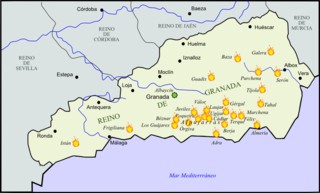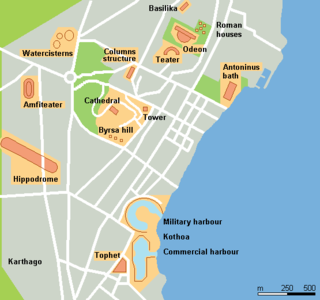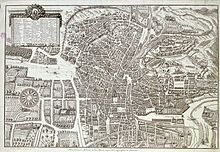
The Senegal River is a 1086-kilometre-long (675 mi) river in West Africa; much of its length marks part of the border between Senegal and Mauritania. It has a drainage basin of 270000 km2, a mean flow of 680 m3/s (24,000 cu ft/s), and an annual discharge of 21.5 km3 (5.2 cu mi). Important tributaries are the Falémé River, Karakoro River, and the Gorgol River. The river divides into two branches once it passes Kaédi The left branch, called the Doué, runs parallel to the main river to the north. After 200 km (120 mi) the two branches rejoin a few kilometers downstream of Podor.

Granada is the capital city of the province of Granada, in the autonomous community of Andalusia, Spain. Granada is located at the foot of the Sierra Nevada mountains, at the confluence of four rivers, the Darro, the Genil, the Monachil and the Beiro. Ascribed to the Vega de Granada comarca, the city sits at an average elevation of 738 m (2,421 ft) above sea level, yet is only one hour by car from the Mediterranean coast, the Costa Tropical. Nearby is the Sierra Nevada Ski Station, where the FIS Alpine World Ski Championships 1996 were held.

The term Moor is an exonym first used by Christian Europeans to designate the Muslim populations of the Maghreb, al-Andalus, Sicily and Malta during the Middle Ages. Moors are not a single, distinct or self-defined people. The 1911 Encyclopædia Britannica observed that the term had "no real ethnological value." Europeans of the Middle Ages and the early modern period variously applied the name to Arabs, Berbers, and Muslim Europeans.

Moriscos were former Muslims and their descendants whom the Catholic Church and Habsburg Spain commanded to forcibly convert to Christianity or face compulsory exile after Spain outlawed Islam. Spain had a sizeable Muslim population, the mudéjars, in the early 16th century.

Al-Andalus was the Muslim-ruled area of the Iberian Peninsula. The term is used by modern historians for the former Islamic states in modern-day Gibraltar, Portugal, Spain, and Southern France. The name describes the different Muslim states that controlled these territories at various times between 711 and 1492. At its greatest geographical extent, it occupied most of the peninsula and part of present-day southern France (Septimania) under Umayyad rule. These boundaries changed constantly through a series of conquests Western historiography has traditionally characterized as the Reconquista, eventually shrinking to the south and finally to the Emirate of Granada.

Abu Abdallah Muhammad XII (c. 1460–1533), known in Europe as Boabdil, was the 22nd and last Nasrid ruler of the Emirate of Granada in Iberia.

Vélez-Málaga is a municipality and the capital of the Axarquía comarca in the province of Málaga, in the Spanish autonomous community of Andalusia. It is the most important city in the comarca. Locally it is referred to as Vélez. Vélez-Málaga is the headquarters of the Commonwealth of Municipalities of Costa del Sol-Axarquía. The municipality forms part of the Costa del Sol region.

The second rebellion of the Alpujarras, sometimes called the War of the Alpujarras or the Morisco Revolt, was the second such revolt against the Castilian Crown in the mountainous Alpujarra region and on the Granada Altiplano region, northeast of the city of Granada. The rebels were Moriscos, the nominally Catholic descendants of the Mudéjares following the first rebellion of the Alpujarras (1499–1501).

The Battle of Carthage was fought in 698 A.D. between a Byzantine expeditionary force and the armies of the Umayyad Caliphate. The battle was a lynchpin of the ongoing Muslim conquest of the Maghreb and put remaining Byzantine resistance to rest.

The Albaicín, also known as Albayzín, is a neighbourhood of Granada, Spain. It is centered around a hill on the north side of the Darro River which passes through the city. The neighbourhood is notable for its historic monuments and for largely retaining its medieval street plan dating back to the Nasrid period, although it nonetheless went through many physical and demographic changes after the end of the Reconquista in 1492. It was declared a World Heritage Site in 1994, as an extension of the historic site of the nearby Alhambra.

The Taifa of Granada or Zirid Kingdom of Granada was a Muslim kingdom that was formed in al-Andalus in 1013 following the deposition of Caliph Hisham II in 1009. The kingdom was centered on Granada, its capital, and it also extended its control to Málaga for a period. Four kings succeeded each other during its nearly 80 years of existence, all of them belonging to an offshoot of the Zirid dynasty of North Africa, a Sanhaja Berber clan. The Taifa of Granada was considered to be the wealthiest out of all of the taifa kingdoms. It was eventually conquered by the Almoravids in 1090, putting an end to Zirid rule in Granada.

The Emirate of Granada, also known as the Nasrid Kingdom of Granada, was an Islamic polity in the southern Iberian Peninsula during the Late Middle Ages, ruled by the Nasrid dynasty. It was the last independent Muslim state in Western Europe.

The Cathedral of Málaga is a Roman Catholic church in the city of Málaga in Andalusia in southern Spain. It is in the Renaissance architectural tradition. The cathedral is located within the limits defined by a now missing portion of the medieval Moorish walls, the remains of which surround the nearby Alcazaba and the Castle of Gibralfaro. It was constructed between 1528 and 1782, following the plans drawn by Diego de Siloe; its interior is also in Renaissance style.

Arenas is a municipality in the province of Málaga located in the autonomous community of Andalusia in southern Spain. It is situated in the comarca of Axarquía. By way of road it is located 12 kilometers from Vélez-Málaga, 50 km from Málaga and 577 km from Madrid. It is located northwest of the Axarquia, between the sierras of Tejeda and Almijara and the Castle of Bentomiz.

Íñigo López de Mendoza y Mendoza was a Spanish noble, military, diplomat and politician in the service of King Philip II of Spain. He was the 4th Count of Tendilla and 3rd Marquis of Mondejar.

The 1487 siege of Málaga was an action during the Reconquest of Spain in which the Catholic Monarchs of Spain conquered the city of Mālaqa from the Emirate of Granada. The siege lasted about four months. It was the first conflict in which ambulances, or dedicated vehicles for the purpose of carrying injured persons, were used. Geopolitically, the loss of the emirate's second largest city—after Granada itself—and its most important port was a major loss for Granada. Most of the surviving population of the city were enslaved or put to death by the conquerors.

Bentomiz Castle is an ancient Moorish fortress built on a hill near the village of Arenas in the province of Málaga. It sits at a height of 711 metres (2,333 ft), and lies to the northeast of Vélez-Málaga.
Abu al-Hassan Ali al-Mandari al-Garnati, also known as Almandari, Almandali, Al-Mandri I and Sidi al-Mandri, was the re-founder of the city of Tetouan in Morocco. He was born in Granada, Spain c.1440 and died in Tétouan on an unknown date in between 1515 and 1541.

Ventas de Zafarraya is a village in the municipality of Alhama de Granada, Granada, Spain. It is just north of a mountain pass between spurs of the Sierra de Alhama to the west and the Sierra de Tejeda to the east, on the main road from Vélez-Málaga to Alhama de Granada. The village was destroyed by an earthquake in 1884, but was rebuilt.


















